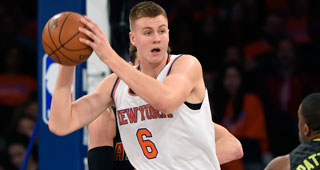Player comparisons can be incredibly challenging at the NBA level because of unique skillsets and roles. The last few days have generated a fascinating discussion around Kristaps Porzingis that provides a good opportunity to shed light on one way to test ideas out.
The only place to start is with the identifying characteristics of the player- the key parts of their game. Porzingis has a truly rare duality at his core: an ability to shoot threes while grabbing a lot of offensive rebounds.
Figuring out which offensive rebounding stat to use is simple since offensive rebound percentage (or rate) adjusts to factors like pace but three point shooting gets more complicated. The three basic pots to consider are rate (how many threes he takes), success (how many go in in number or percentage) and ratio (what proportion of the shots he takes are threes). Even though this is Porzingis’ first NBA season, he has played professionally before and RealGM has an excellent record of his European track record. Both the amount of threes he takes and the proportion of his shots from distance are pretty consistent with his ACB play with the exception of last season for Sevilla when a whopping 60 percent of his shot attempts came from three. Despite that, his time with the Knicks looks fairly representative of his play in Europe so it feels better to think of it as a more representative sample.
Focusing just on this offensive duality produces an interesting list including multiple appearances from contemporaries Ryan Anderson, Kevin Love and Jared Sullinger. Love stands out because it is Minnesota Kevin Love rather than the more current iterations because Love’s growing perimeter game has taken him too far out of the lane to get offensive rebounds at a high enough rate. The middle of his transition from glass cleaner to stretch four provides the closest comparison in his career and also illustrates a choice the Knicks hope they will not have to make with the larger Porzingis.
Just looking at offensive boards and three point shooting cannot be enough for a proper comparison. There are two other parts of Porzingis’ game that stand out: he blocks a fair amount of shots (his 4.6% block percentage is 26th in the league) and does not get many assists, which both parallel his time in Sevilla the last three seasons. Adding those into the mix takes out some current players and narrows the field to some truly interesting comparisons.
Like Porzingis, Raef LaFrentz bounced between power forward and center. LaFrentz’s offensive rebounding usually stuck a little below where Porzingis is now but he had a few seasons above 9 percent (which is very good) and the three point attempts align pretty well throughout his career. Other than a spike in playmaking in Boston, Raef had a similar offensive niche and blocked shots pretty well at both big man spots. At this point, young Raef LaFrentz probably serves as the best comp for Porzingis though it is worth noting that KP’s rookie year is coming about two years younger than LaFrentz’s.
The other comparable player is even more interesting. Eddie Griffin (RIP) began his career at power forward next to Yao Ming on the Rockets but also played with Kevin Garnett and the Timberwolves right after their Western Conference Finals appearance. Griffin was another PF/C hybrid that grabbed a lot of offensive rebounds and took threes at an eerily similar rate to Porzingis. His age-20 season, Griffin took 28.3 percent of his shots from three and made 33.3 percent of them while Porzingis is at 25.1 percent of attempts and a 34 percent success rate right now. Griffin also blocked shots similarly and only assisted on more than 6.5 percent of his team’s plays once in five seasons. Sadly, Griffin’s career and life were cut short by off the court issues.
What made finding comparable players for Porzingis even more compelling were some of the players who popped up during different searches. Robert Horry came up at various moments in his career as a player whose offensive and defensive responsibilities varied intensely over time. Former Blazer and Sonic Dontonio Wingfield (actually the name inspiration for a Kevin Pelton / Ben Golliver podcast years ago) combined rebounding and shooting in a similar way from the small forward position but could not emulate Porzingis’ block rate for logical reasons. Finally, Al-Farouq Aminu’s 2014-15 season under Rick Carlisle and Charles Barkley’s first season with the Rockets when he took a bunch of threes were aberrations for them that align loosely with what Porzingis is doing right now.
More than anything, this exercise shows how Kristaps Porzingis’ skillset stands out even in a league full of dynamic players. If he can expand his game while maintaining his uncommon ability to hit threes and crash the offensive glass, the new golden boy of New York could chart his own path to success in the NBA.



